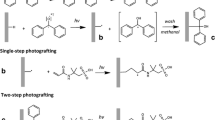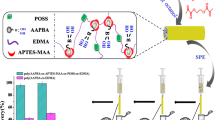Abstract
A hybrid monolith was prepared from perovskite and cucurbit[6]uril [poly(hydroxyethyl methacrylate-pentaerythritol triacrylate) monolith] for the enrichment of phosphopeptides. By coupling with mass spectrometry, three goals were simultaneously realized, viz. (a) selective enrichment of phosphopeptides from non-phosphopeptides, (b) identification of mono- and multi-phosphopeptides, and (c) recognition of tyrosine phosphopeptides. The perovskite introduced into the monolith warrants high selectivity for phosphopeptides even at a high (10,000:1) ratio of non-phosphopeptides to phosphopeptides, and and enables identification of eight mono- and multi-phosphopeptides from standard β-casein tryptic digests. Tyrosine phosphopeptides were specifically detected via the recognition capability of cucurbit[6]uril integrated into the monolith. The method has remarkably specific enrichment capacity for phosphopeptides from samples including human serum, nonfat milk, and human acute myelocytic leukemia cell lysate.

Schematic representation of a monolith integrated with perovskite and cucurbit[6]uril. The monolithic column was coupled with mass spectrometry and applied to the enrichment of phosphopeptides. The method has remarkably specific enrichment capacity for phosphopeptides from complex biological samples.







Similar content being viewed by others
References
Wiseman RL, Kelly JW (2011) Phosphatase inhibition delays translational recovery. Science 332:44–45
Wilhelm M, Schlegl J, Hahne H, Gholami AM, Lieberenz M, Savitski MM, Ziegler E, Butzmann L, Gessulat S, Marx H, Mathieson T, Lemeer S, Schnatbaum K, Reimer U, Wenschuh H, Mollenhauer M, Slotta-Huspenina J, Boese JH, Bantscheff M, Gerstmair A, Faerber F, Kuster B (2014) Mass-spectrometry-based draft of the human proteome. Nature 509:582–587
Nita-Lazar A, Saito-Benz H, White FM (2008) Quantitative phosphoproteomics by mass spectrometry: past, present, and future. Proteomics 8:4433–4443
Li XS, Yuan BF, Feng YQ (2016) Recent advances in phosphopeptide enrichment: strategies and techniques. TRAC-Trend Anal Chem 78:70–83
Yao J, Sun N, Deng C (2018) Recent advances in mesoporous materials for sample preparation in proteomics research. TRAC-Trend Anal Chem 99:88–100
Possemato AP, Paulo JA, Mulhern D, Guo A, Gygi SP, Beausoleil SA (2017) Multiplexed phosphoproteomic profiling using titanium dioxide and immunoaffinity enrichments reveals complementary phosphorylation events. J Proteome Res 16:1506–1514
Dehghani A, Godderz M, Winter D (2018) Tip-based fractionation of batch-enriched phosphopeptides facilitates easy and robust phosphoproteome analysis. J Proteome Res 17:46–54
Liu M, Tran TM, Abbas Elhaj AA, Boen Torsetnes S, Jensen ON, Sellergren B, Irgum K (2017) Molecularly imprinted porous monolithic materials from melamine-formaldehyde for selective trapping of phosphopeptides. Anal Chem 89:9491–9501
Zhang KN, Hu DH, Deng SM, Han M, Wang XF, Liu HL, Liu Y, Xie MX (2019) Phytic acid functionalized Fe3O4 nanoparticles loaded with Ti(IV) ions for phosphopeptide enrichment in mass spectrometric analysis. Microchim Acta 186:10
Zhong H, Xiao X, Zheng S, Zhang W, Ding M, Jiang H, Huang L, Kang J (2013) Mass spectrometric analysis of mono- and multi-phosphopeptides by selective binding with NiZnFe2O4 magnetic nanoparticles. Nat Commun 4:1656
Leitner A, Sakeye M, Zimmerli CE, Smatt JH (2017) Insights into chemoselectivity principles in metal oxide affinity chromatography using tailored nanocast metal oxide microspheres and mass spectrometry-based phosphoproteomics. Analyst 142:1993–2003
Luo B, Yang M, Jiang P, Lan F, Wu Y (2018) Multi-affinity sites of magnetic guanidyl-functionalized metal-organic framework nanospheres for efficient enrichment of global phosphopeptides. Nanoscale 10:8391–8396
Huang X, Wang J, Liu C, Guo T, Wang S (2015) A novel rGR–TiO2–ZrO2 composite nanosheet for capturing phosphopeptides from biosamples. J Mater Chem B 3:2505–2515
Hong Y, Pu C, Zhao H, Sheng Q, Zhan Q, Lan M (2017) Yolk-shell magnetic mesoporous TiO2 microspheres with flowerlike NiO nanosheets for highly selective enrichment of phosphopeptides. Nanoscale 9:16764–16772
Li XS, Chen X, Sun H, Yuan BF, Feng YQ (2015) Perovskite for the highly selective enrichment of phosphopeptides. J Chromatogr A 1376:143–148
Bllaci L, Torsetnes SB, Wierzbicka C, Shinde S, Sellergren B, Rogowska-Wrzesinska A, Jensen ON (2017) Phosphotyrosine biased enrichment of tryptic peptides from cancer cells by combining pY-MIP and TiO2 affinity resins. Anal Chem 89:11332–11340
Sharma K, D'Souza RC, Tyanova S, Schaab C, Wisniewski JR, Cox J, Mann M (2014) Ultradeep human phosphoproteome reveals a distinct regulatory nature of Tyr and Ser/Thr-based signaling. Cell Rep 8:1583–1594
Bian Y, Li L, Dong M, Liu X, Kaneko T, Cheng K, Liu H, Voss C, Cao X, Wang Y, Litchfield D, Ye M, Li SS, Zou H (2016) Ultra-deep tyrosine phosphoproteomics enabled by a phosphotyrosine superbinder. Nat Chem Biol 12:959–966
Li Y, Wang Y, Dong M, Zou H, Ye M (2017) Sensitive approaches for the assay of the global protein tyrosine phosphorylation in complex samples using a mutated SH2 domain. Anal Chem 89:2304–2311
Yao Y, Bian Y, Dong M, Wang Y, Lv J, Chen L, Wang H, Mao J, Dong J, Ye M (2018) SH2 superbinder modified monolithic capillary column for the sensitive analysis of protein tyrosine phosphorylation. J Proteome Res 17:1243–1251
Zheng H, Li X, Jia Q (2018) Self-assembling glutamate-functionalized cyclodextrin molecular tube for specific enrichment of N-linked glycopeptides. ACS Appl Mater Interfaces 10:19914–19921
Jiang D, Li X, Jia Q (2018) Multilayer cucurbit[6]uril-based magnetic nanoparticles prepared by host-guest interaction: remarkable adsorbent for low density lipoprotein removal from plasma. Chem Eur J 24:2242–2248
Chinai JM, Taylor AB, Ryno LM, Hargreaves ND, Morris CA, Hart PJ, Urbach AR (2011) Molecular recognition of insulin by a synthetic receptor. J Am Chem Soc 133:8810–8813
Cox HA, Hodyss R, Beauchamp JL (2005) Cluster-phase reactions: gas-phase phosphorylation of peptides and model compounds with triphosphate anions. J Am Chem Soc 127:4084–4090
Rekharsky MV, Yamamura H, Ko YH, Selvapalam N, Kim K, Inoue Y (2008) Sequence recognition and self-sorting of a dipeptide by cucurbit[6]uril and cucurbit[7]uril. Chem Commun 19:2236–2238
Zhang M, Wei F, Zhang YF, Nie J, Feng YQ (2006) Novel polymer monolith microextraction using a poly(methacrylic acid-ethylene glycol dimethacrylate) monolith and its application to simultaneous analysis of several angiotensin II receptor antagonists in human urine by capillary zone electrophoresis. J Chromatogr A 1102:294–301
Ohzuku H, Ikeno H, Yamada I, Yagi S (2016) First-principles calculations of the OH- adsorption energy on perovskite oxide. AIP Conf Proc 1763:040005
Zhang HJ, Huang JF, Wang H, Feng YQ (2006) Determination of low-aliphatic aldehyde derivatizatives in human saliva using polymer monolith microextraction coupled to high-performance liquid chromatography. Anal Chim Acta 565:129–135
Cao LC, Zhao YM, Chu ZY, Zhang XM, Zhang WB (2020) Core-shell magnetic bimetallic MOF material for synergistic enrichment of phosphopeptides. Talanta 206:120165
Wu YL, Liu QJ, Xie YP, Deng CH (2018) Core-shell structured magnetic metal-organic framework composites for highly selective enrichment of endogenous N-linked glycopeptides and phosphopeptides. Talanta 190:298–312
Sun NR, Wang JW, Yao JZ, Chen HM, Deng CH (2019) Magnetite nanoparticles coated with mercaptosuccinic acid-modified mesoporous titania as a hydrophilic sorbent for glycopeptides and phosphopeptides prior to their quantitation by LC-MS/MS. Microchim Acta 186:159
Wang JW, Wang ZD, Sun NR, Deng CH (2019) Immobilization of titanium dioxide/ions on magnetic microspheres for enhanced recognition and extraction of mono- and multi-phosphopeptides. Microchim Acta 186:236
Zhang KN, Hu DH, Deng SM, Han M, Wang XF, Liu HL, Liu Y, Xie MX (2019) Phytic acid functionalized Fe3O4 nanoparticles loaded with Ti(IV) ions for phosphopeptide enrichment in mass spectrometric analysis. Microchim Acta 186:68
Lin HZ, Chen HM, Shao X, Deng CH (2018) A capillary column packed with a zirconium(IV)-based organic framework for enrichment of endogenous phosphopeptides. Microchim Acta 185:562
Min Q, Chen X, Zhang X, Zhu JJ (2013) Tailoring of a TiO2 nanotube array-integrated portable microdevice for efficient on-chip enrichment and isotope labeling of serum phosphopeptides. Lab Chip 13:3853–3861
Acknowledgements
This work was supported by Jilin Provincial Science & Technology Department (20190201079JC), the Fundamental Research Funds for the Central Universities, JLU and Open Project of State Key Laboratory of Supramolecular Structure and Materials, Jilin University, China (sklssm2019020).
Author information
Authors and Affiliations
Corresponding author
Ethics declarations
Conflict of interest
The author(s) declare that they have no competing interests.
Additional information
Publisher’s note
Springer Nature remains neutral with regard to jurisdictional claims in published maps and institutional affiliations.
Rights and permissions
About this article
Cite this article
Zheng, H., Jia, Q. A polymer monolith composed of a perovskite and cucurbit[6]uril hybrid for highly selective enrichment of phosphopeptides prior to mass spectrometric analysis. Microchim Acta 187, 68 (2020). https://doi.org/10.1007/s00604-019-4054-9
Received:
Accepted:
Published:
DOI: https://doi.org/10.1007/s00604-019-4054-9




